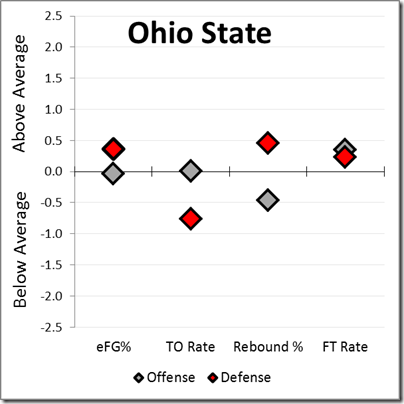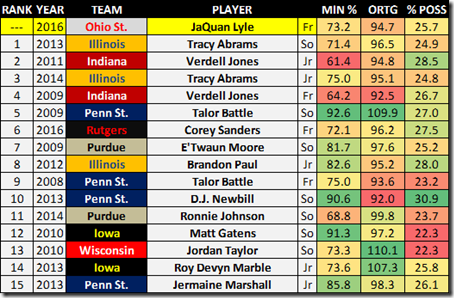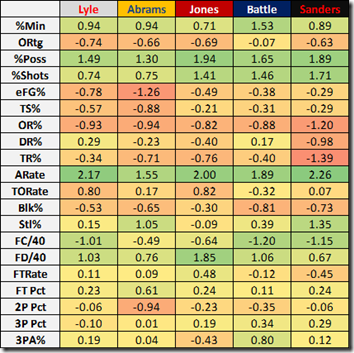2016-17 B1G Basketball Preview: Ohio St.

[via OSU Basketball Twitter]
PREVIOUSLY: Illinois, Indiana, Iowa, Maryland, Michigan, Michigan St., Minnesota, Nebraska, Northwestern
Since starting at Ohio State back in the 2004-5 season, Thad Matta has been one of the Big Ten’s best coaches: his Buckeye teams have been a one- or two-seed in the NCAA Tournament six times, have won five Big Ten titles (and the Big Ten Tournament four times), and have made it to the Final Four twice. Matta’s Ohio State teams have consistently featured one-and-done prospects, usually have some of the stingiest defenses in the country, and his overall work at a football school has been extremely impressive. Even though there’s been a slide in recent years, there’s little doubt that the OSU program is in good hands as long as he’s been in Columbus.
That slide – a six-seed in 2014, a ten-seed in 2015, and then missing the tournament entirely last season – has been a big point of consternation among the Buckeye faithful, and the causes are a topic of debate. Surely the very highly-touted but disappointing 2011 recruiting class played a part, as has the youth of many key players – especially last season. The Buckeyes had no seniors, just one junior, and had freshman JaQuan Lyle in a featured role offensively. Predictably, he was unable to replicate the production of sensational one-and-done guard D’Angelo Russell, and the Buckeyes wound up 76th in Kenpom’s algorithm, by far the worst finish of the Matta era.
[More on the Buckeyes after the JUMP]
Lyle’s struggles – particularly shooting the ball from behind the arc (25% on threes) – were a key part of the Buckeyes’ larger offensive issues, but he didn’t get much help from his teammates. Marc Loving, who was supposed to be a veteran presence and valuable floor-spacer on the wing, struggled through a lackadaisical junior year; Keita Bates-Diop, a versatile swingman, wasn’t able to assert himself offensively; Jae’Sean Tate was best as a defender and rebounder and a shoulder injury wound up cutting his season short; the freshman class outside of Lyle was simply dreadful (and several Buckeyes wound up transferring).
Still, there’s good reason to think that Ohio State is a good candidate for a breakout season – most importantly, their entire main rotation is back on campus, and they’ll only improve, individually and collectively, with time. When Pomeroy’s preseason projections were released, Ohio State was the biggest surprise (definitely in the Big Ten and perhaps nationally), rated the 13th-best team in the country. While that’s unrealistic, a return to the tournament seems likely, based on both precedent and the normal development track of a young team getting experience.
LAST SEASON
Of all the graphics I’ve made in Excel – and there have been a lot – this one was my favorite: nothing better illustrates the concept of decreasing efficiency with increasing usage than this very tidy distribution of players from 2015-16 Ohio State. The little cluster of freshmen who transferred out (and may have been the victims of Spring Creaning, as far as we know) makes it even better; maybe those guys saw the writing on the wall after struggling mightily through their freshman seasons. Only one – Daniel Giddens – wound up at a major-conference program.
The top six Buckeyes were an interesting mix. JaQuan Lyle had a great assist rate but was turnover-prone and his three-point shooting was a huge drag on his efficiency. He was able to get to the basket quite a bit and shot 54% on those attempts, which is pretty solid for a de facto point guard. On the other side of the coin, Kam Williams – a three-point sharpshooter who connected on 44% of his long-range attempts – was the high-efficiency / low-usage yin to Lyle’s yang.
The cluster of players in the middle featured guys who were mostly similar to one another, outside of Marc Loving, who took the most three-point attempts on the team – his percentage (34%) wasn’t great in a vacuum, but looked even worse when juxtaposed to his excellent sophomore marksmanship (46%). Jae’Sean Tate had a weird profile for his size – just 6’4 – taking most of his shots around the basket and finishing with an excellent 55% number on all of his two-point attempts (though his free throw shooting was surprisingly terrible). Keita Bates-Diop had a low turnover rate but hasn’t shown off the playmaking he was reputed to have as a recruit. Trevor Thompson’s minutes were limited by his foul problems, and he was more impactful on defense than on offense.
Four Factor Z-Scores from games against Big Ten opponents
While the Buckeye defense was markedly better than the offense overall on the season, they were both pretty close to average in Big Ten play – and their distribution of four factor statistics are remarkably close to average marks across the league over the past five seasons. They were best at shot defense, equally proficient at both two- and three-point defense, but their turnover creation was atypically low for a Matta team.
On offense, they were mediocre in most statistical categories, but on the aggregate, came very close to average; their best statistical attribute was their ability to get to the free throw line – Loving, Thompson, and Lyle led the charge in that regard.
NEWCOMERS
Because of the transfers, Ohio State will probably be forced to rely on some of their incoming freshmen this season. Matta decided to stay home in Ohio – a change in strategy, given the composition of recent classes – for most of his prospects, and the class checks out right around the middle of the Big Ten. The headliner is big man Derek Funderburk, a Top 100 big man who’s listed as a center on 247 and other recruiting sites, but is probably too thin to play the position at the college level right away. Funderburk is very athletic, has a nice frame, and could probably guard both forward positions right now; if he’s able to develop into a player who can guard fives, Ohio State’s offense will be given an added degree of dynamism.
Two other Ohioans are in the class, both generic 3* prospects. Micah Potter is also listed as a center by recruiting sites, but he has the profile of a stretch-5, which would be unusual for the Buckeyes, who have gone for more traditional big men under Matta. With two centers potentially ahead of him on the depth chart (not including Funderburk), playing time might be hard to come by. The other freshman is Andre Wesson, a 3-and-D wing prospect who could theoretically guard multiple positions; like Potter, the depth chart makes significant minutes unlikely.
Ohio State went down to Florida and signed JUCO point guard CJ Jackson, who has three remaining years of eligibility, and with AJ Harris’s transfer, he’s pretty much guaranteed to play some role on the 2016-17 Buckeyes – probably backing up Lyle at the point (though Lyle might be best as a two, and if Jackson is ready to play significant minutes, there will be an opportunity for it). Jackson is known first and foremost as a shooter, which will surely improve Ohio State’s spacing. He’s emblematic of a seemingly different recruiting strategy for Ohio State – Jackson wasn’t a highly-touted prospect but could fit in nicely because his skill set differs from the established players on the roster.
PROJECTED ROTATION
-
STARTER (COMBO GUARD) – JaQuan Lyle (So, 6’5, 210): Promising sophomore spent a year at prep school and is old for his class, struggled with efficiency but could create for himself and others, was once considered an NBA prospect but that talk has cooled off.
-
STARTER (WING) – Marc Loving (Sr, 6’8, 220): Often criticized by fans for his body language, got better at driving to the basket and scoring at the rim, if his three-point shooting improves to what it once was, could be Ohio State’s best offensive weapon.
-
STARTER (WING) – Keita Bates-Diop (Jr, 6’7, 235): Great block rate for his size indicates defensive ability, was an effective scorer inside the arc, good rebounder, avoided fouls, three-point shot was a liability and hurt spacing.
-
STARTER (TRADITIONAL FOUR) – Jae’Sean Tate (Jr, 6’4, 230): One of the most unique players in the Big Ten, very physical though undersized, great steal rate, surprisingly strong rebounder, effective scorer near the basket but little range to his game.
-
STARTER (POST) – Trevor Thompson (Jr, 7’0, 250): Split minutes with Giddens last season, block rate indicates excellent rim protection, turnover rate suggests bad hands, good free throw shooter and gets to the line, predictably strong rebounder.
-
BENCH (POINT GUARD) – CJ Jackson (So, 6’1, 175): Former Montverde Prep player spent a year at a JUCO before getting an OSU offer, great shooter, should provide spacing, will play rotation minutes right away.
-
BENCH (GUARD) – Kam Williams (R-Jr, 6’2, 185): Sixth man and excellent outside shooter has the “just a shooter” profile (low TO rate, low fouls, no rebounding, etc.) but takes a good amount of shots from inside the arc as well, where he’s less effective.
-
BENCH (WING) – Andre Wesson (Fr, 6’6, 220): 3-and-D wing was a local prospect added to the class late, probably stuck behind Loving, Bates-Diop, Tate, and Williams in the rotation.
-
BENCH (WING) – Derek Funderburk (Fr, 6’9, 205): Enigmatic big man was listed as a high school center and could play there eventually, but more likely to get minutes at the four because of his defense and athleticism.
-
BENCH (POST) – David Bell (R-So, 6’9, 225): Little-used reserve last season was stuck behind Giddens on the depth chart, which doesn’t bode well for him, could cede minutes to stretch-five Micah Potter as the year goes on.
PLAYER COMPARISON
A few years ago, I came up with a system that would compare the statistical profiles of Big Ten players to their historical counterparts by taking the sum of the differences between a given player’s profile and each of the thousand player-seasons from 2008-present in twenty different statistical categories.
# value is the Z-Score of the player’s statistic (or statistics averaged over multiple seasons) relative to the entire sample
JaQuan Lyle came in to Ohio State with quite a bit of hype, and even though it was pretty obvious that he wouldn’t be able to replicate D’Angelo Russell’s level of production, his struggles as a freshman were somewhat of a surprise. First, his efficiency was an issue all year; even though he was able to distribute the ball better than anyone else on the roster, he struggled with turnovers and his shot chart – which featured plenty of suboptimal mid-range attempts from the elbows – wasn’t great. Lyle has a lot of potential and typically when young players are thrust into a high-usage role, they fail.
Still, the names that come up as his most statistically comparable are pretty discouraging. Tracy Abrams – he of the very low two-point shooting percentage – and Verdell Jones were iffy role players at best, and that they’re the strongest correlation with Lyle doesn’t speak well to his upside. Talor Battle is the best player on the list and his seasons as a younger player (particularly as a freshman) could suggest that Lyle has the potential to develop into something similar to Battle. Corey Sanders – another freshman last season – might be the best single comparison for Lyle: he’s an attacking guard that had similar efficiency issues because of his level of offensive responsibility.
OUTLOOK
In some ways, Michigan and Ohio State each have very similar outlooks for the upcoming season. Last year, both teams finished right at the middle of the conference; both teams return all five starters – continuity that’s pretty rare in today’s day and age; both teams will be forced to play newcomers in the rotation because of bench depth that transferred out of the program. Even though Ohio State didn’t reach the NCAA Tournament like Michigan did, the similarities are striking.
For OSU to break through and make the tournament, they’ll need those familiar rotation cogs to take some steps forward. JaQuan Lyle is the most important piece of the puzzle: the rising sophomore has an intriguing offensive game and could benefit if CJ Jackson allows him to play off the ball a little bit, but he’ll need to be more efficient to help lead the Buckeyes forward. If Marc Loving can fuse together the best parts of his sophomore and junior campaigns (three-point shooting and getting to the basket, respectively), he could have a breakout season. Keita Bates-Diop and Jae’Sean Tate are a solid forward combo in theory, but they both seemingly have plenty of room for improvement. Trevor Thompson needs to be able to stay on the floor.
Last season was a bitter pill to swallow for a program that has seen sustained success for most of the last decade; in hindsight, perhaps it was inevitable that such a young team would struggle, but no Matta team had ever performed as poorly as the 2015-16 Buckeyes did. The attrition after the season was probably a good thing, freeing up scholarships for players more likely to be positive contributors, but that means that OSU will have to rely heavily on its nucleus of returners – the reinforcements coming in aren’t as good (on paper) as they have been under Matta.
While it’s unlikely that OSU vaults into the Top 15 nationally – like Kenpom is projecting – substantial improvement is realistic; Lyle’s improvement will be the biggest storyline moving forward for the program – if he can be a top-tier guard in the Big Ten, OSU will be in the picture to finish in the top four of the league.
November 8th, 2016 at 6:29 PM ^
Please stop posting this picture. My eyes can't take it!
November 8th, 2016 at 6:36 PM ^
November 9th, 2016 at 8:17 AM ^
I thought Aaron Craft used up all his eligibilty?!?!
November 8th, 2016 at 6:53 PM ^
My eyes. They burn.
November 9th, 2016 at 6:10 AM ^
Aaron Craft in his 40th year of eligibility, still "hustling."
November 8th, 2016 at 6:31 PM ^
The pic makes it official. Thad Matta IS a goblin.
November 8th, 2016 at 6:58 PM ^
November 9th, 2016 at 8:54 AM ^
As an IU fan, I watched (sometimes through my fingers) during the first couple of Crean years, when Verdell was IU's primary point guard and scoring threat. He was... an ok B1G player, and a nice (and starting) piece as a senior on IU's 2011 Sweet 16 team. But the dude wasn't cut out to be the go-to scorer and ballhandler, which was the situation his first couple of years. Lots of turnovers and many questionable decisions led to significant inefficiency.
Frankly, that seems to be where OSU was mired last season - a young team with some talent but little identity or experience playing together, with an underclassman guard trying to do it all. That almost never works out. So, Lyle may end up, like Jones did, as a critical cog on a team with multiple offensive threats - a guy who, when he didn't have to be the everything guy, could be quite solid, though not all-B1G level.
But that'll depend on Matta's ability to actually build a team. The massive roster churn OSU has been experiencing may make that difficult to accomplish. IU has had a pretty quiet year-plus now on that front, much to my relief. Can Matta bloom again, late in his career? Or are his best years behind him? I'm hoping for the latter.
November 9th, 2016 at 10:05 AM ^
He looks older than 49 in a basketball uniform but a little younger here.
November 9th, 2016 at 11:51 AM ^
I always think of this man

...and now you will too






Comments